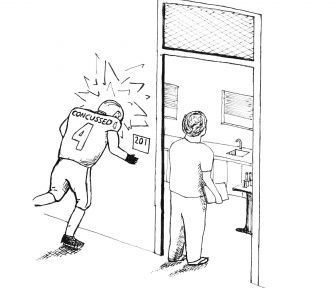If a school activity was reported to cause brain damage, the likely solution would be to quit endorsing that activity.
If students wanted to start a school-sponsored club that resulted in concussions for 20 percent of participants, the administration would probably stop them.

Schools make huge efforts to keep their students safe, but there is a huge discrepancy in their policies: the support of a football program.
By fielding a football team, the school is permitting football players to subject themselves to the chance of long-term brain damage.
Redwood’s purpose as an educational institution is to promote and value academics. Thus, the very presence of a football team contradicts the school’s mission.
It’s true that football is a school tradition, and it would be a shame to give up the school spirit that it promotes. But there are other activities that contribute to school spirit, and it’s possible for even a long-standing tradition to be stopped.
For many years, football was accepted because it was not known to be too dangerous. Now, the effects of head injuries caused by football are of increasing concern.
Players try to diminish the risk of head injuries by wearing bigger helmets and promoting safety. But the truth is that they can only do so much without changing the nature of the sport. The risk of concussions and more severe head injuries is still present.
Up to 20 percent of high school and college football players will suffer a concussion this season, according to the American Association of Neurological Surgeons. Countless more players will suffer concussions but go undiagnosed, and still more will suffer smaller, harder-to-detect injuries.
In the short term, concussions can cause memory loss, confusion and many other ailments. Students who suffer concussions might miss lots of school, or they could have difficulty concentrating, taking a huge toll on their academic and personal lives.
More gravely, a concussion sustained at a young age can be debilitating in the long term. Multiple studies have connected concussions to chronic traumatic encephalopathy (CTE), a condition that leads to early-onset dementia, personality changes and suicidal behavior.
CTE’s symptoms become visible many years after the concussions are suffered, meaning that someone who plays freshman football now could suffer terribly in 30 or 40 years.
Last month, the NFL paid hundreds of millions of dollars in settlements to more than 4,500 of its former players after some of them were diagnosed with CTE.
The implications of this issue extend beyond the NFL. If a Redwood student were to realize that his health problems were caused by playing high school football, who’s to stop him from filing suit against the school?
Unfortunately, the NFL’s suit and the reasons behind it have not completely reached the right audience. Children and adolescents are still playing and supporting football as much as ever, even while studies repeatedly show the grave consequences of ramming one’s head into someone else’s body at high speeds.
This is alarming for two reasons. First, the brain of an adolescent is still developing, so a traumatic injury can affect it even more drastically. Second, when choosing to join a football team, many students do not consider their brain’s safety.
It’s undeniable that playing football increases chances of brain injury and other health problems. So why do we allow our friends and our children to continue playing?
We could continue to promote the football team, and continue to overlook the grave effects that many football players will experience. Or, maybe, we could start watching soccer.












